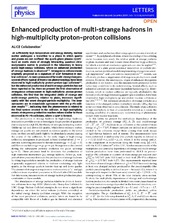Enhanced production of multi-strange hadrons in high-multiplicity proton-proton collisions
Adam, Jaroslav; Adamová, Dagmar; Aggarwal, Madan M.; Aglieri Rinella, Gianluca; Agnello, Michelangelo; Agrawal, Nikita; Ahammed, Zubayer; Ahmad, Shafiq F.; Ahn, Sang Un; Aiola, Salvatore; Alme, Johan; Helstrup, Håvard; Hetland, Kristin Fanebust; Kileng, Bjarte; Altinpinar, Sedat; Djuvsland, Øystein; Lønne, Per-Ivar; Nystrand, Joakim; Rehman, Attiq ur; Røhrich, Dieter; Tambave, Ganesh Jagannath; Ullaland, Kjetil; Velure, Arild; Wagner, Boris; Zhang, Hui; Zhou, Zhuo; Zhu, Hongsheng; Arsene, Ionut Christian; Bätzing, Paul Christoph; Dordic, Olja; Lindal, Svein; Mahmood, Sohail Musa; Milosevic, Jovan; Qvigstad, Henrik; Richter, Matthias; Røed, Ketil; Skaali, Toralf Bernhard; Tveter, Trine Spedstad; Wikne, Jon Christopher; Zhao, Chengxin; Langøy, Rune; Lien, Jørgen André; Akindinov, Alexander; Alam, Sk Noor; De Albuquerque, Danilo Silva; Aleksandrov, Dimitry; Alessandro, Bruno; Alexandre, Didier; Alfaro Molina, José Rubén; Alici, Andrea; ALICE, Collaboration
Peer reviewed, Journal article
Published version

Åpne
Permanent lenke
https://hdl.handle.net/1956/17916Utgivelsesdato
2017Metadata
Vis full innførselSamlinger
Originalversjon
https://doi.org/10.1038/nphys4111Sammendrag
At sufficiently high temperature and energy density, nuclear matter undergoes a transition to a phase in which quarks and gluons are not confined: the quark–gluon plasma (QGP)1. Such an exotic state of strongly interacting quantum chromodynamics matter is produced in the laboratory in heavy nuclei high-energy collisions, where an enhanced production of strange hadrons is observed2, 3, 4, 5, 6. Strangeness enhancement, originally proposed as a signature of QGP formation in nuclear collisions7, is more pronounced for multi-strange baryons. Several effects typical of heavy-ion phenomenology have been observed in high-multiplicity proton–proton (pp) collisions8, 9, but the enhanced production of multi-strange particles has not been reported so far. Here we present the first observation of strangeness enhancement in high-multiplicity proton–proton collisions. We find that the integrated yields of strange and multi-strange particles, relative to pions, increases significantly with the event charged-particle multiplicity. The measurements are in remarkable agreement with the p–Pb collision results10, 11, indicating that the phenomenon is related to the final system created in the collision. In high-multiplicity events strangeness production reaches values similar to those observed in Pb–Pb collisions, where a QGP is formed.
